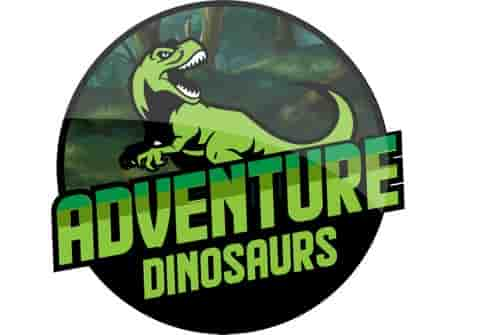Real Dinosaur Tracks, what can tease the imagination more than seeing giant footprints in stone and recognizing that they are confirmed to be made by dinosaurs. Making tracks in the sand is something that everyone has done at the beach or lakeshore. No matter how many footprints you make, a few waves can completely wipe them out, leaving little trace of the footprints you just made. When it comes to dinosaurs, it’s amazing to learn that we can still see real dinosaur tracks after millions of years. It makes me wonder how they could endure the test of time? And even more, where are the best tracks located?
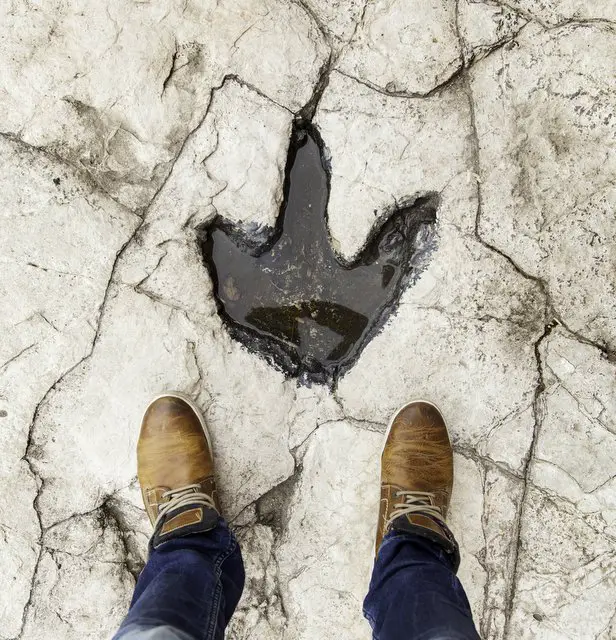
Where Can You See Real Dinosaur Tracks?
So, where can you see real dinosaur tracks? Paleontologists have discovered fossilized dinosaur tracks (ichnites) on every continent, even Antarctica. In the US, you can see tracks at:
● Dinosaur Valley State Park (TX)
● Dinosaur Ridge (CO)
● Dinosaur State Park (CT)
● Clayton Lake State Park (NM)
● Dinosaur Footprints Wilderness Reservation (MA)
● Denali National Park (AK)
Outside of the US, you can see them at:
● Isle of Skye, Staffin Beach (Scotland)
● Cal Orcko (Bolivia)
● Dampier Peninsula (Australia)
● La Rioja (Spain)
● The Keates Quarry, Jurassic Coast (UK)
● Plagne, Jura Mountains (France)
● Natural Dinosaurs Footprints Monument (Portugal)
● Grande Cache Dinosaur Tracksite, (Canada)
● Zhucheng City (China)
It would make sense that dinosaur tracks are found close to their fossils, but that isn’t always the case. Sometimes, dinosaur tracks are found in places where there isn’t a fossilized bone anywhere close by.
Dinosaur tracks usually help paleontologists to reaffirm a lot of the hypotheses they make from dinosaur fossils. They give lots of insights regarding the varied species and even help reaffirm distinctive differences between dinosaurs and crocodilians. One of the reasons that confirm dinosaurs existed is their universally-spread tracks. Let’s take this chance to explore the world of dinosaurs by tracing their tracks.
Dinosaur Valley State Park, located in Texas, USA, stands as a prominent landmark preserving dinosaur tracks. La Rioja, Spain, similarly exhibits an engaging view of prehistoric footprints. Gantheaume Point in Broome, Australia, alongside Dinosaur Cove in Victoria, provide evidence of the Australian dinosaur era in the shape of their tracks.
Table of Contents
Moving continents, the Morrison Natural History Museum, located in Colorado, USA, narrates the story of dinosaur evolution via tangible fossilized prints. Bolivia’s Cal Orcko brings its viewers face to face with the realities of the dinosaur era through its rich collection of footprints.
The St. George Dinosaur Discovery Site, and Cleveland-Lloyd Dinosaur Quarry, housed in Utah, USA, underline the dinosaur age with their preserved tracks. Dinosaur Ridge, Colorado, and Dinosaur State Park, Connecticut also host a range of these invaluable footprints.
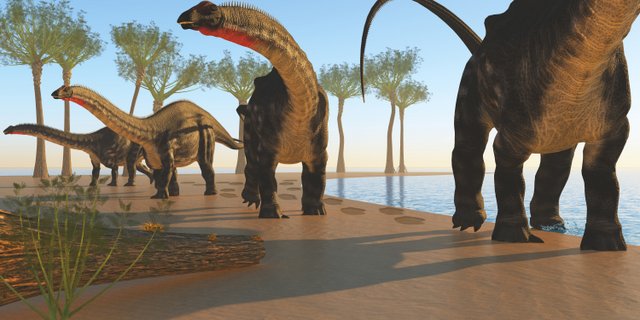
In Canada, Dinosaur Provincial Park underlines the North American dinosaur history. Fossil Trace Golf Club in Colorado uniquely integrates golfing amidst real dinosaur tracks. Vale of Glamorgan, Wales allows enthusiasts to tread the path of history. Paluxy River, Texas, and Tuba City, Arizona, are renowned for their trace fossils, while Beijing’s Yanqing Global Geopark underscores Asian dinosaur heritage.
In Europe, Isona I Conca Dellà, Catalonia, Spain, and Praia de Santa Cruz, Portugal, are significant sites for these relics. Australia’s Rosedale, Victoria, unveils part of the continent’s dinosaur history and finally, the Prince Creek Formation in Alaska, USA, offers a chilling glimpse into dinosaur track preservation. Each location serves as a testament to the fascinating life forms that once walked the Earth.
Nature had ways to preserve the precious footprints so we could infer social cues and hunting patterns. Let’s get down to find out where we can find dinosaur tracks, and what they can tell us about the prehistoric tyrants.
How Do Dinosaur Footprints Survive?
About 90% of animal tracks are covered or destroyed by natural elements. Rarely, however, Mother Nature preserves animal tracks. Sometimes, the tracks may remain intact for so long that they become fossilized. Prehistoric dinosaur tracks are the best example in this case.
Animals make tracks when the force of their weight makes an impression on the ground they are walking over. If the soil is soft, an impression can be made, but the ground that is too soft in texture collapses tracks, like with dry beach sand. If the ground is very hard, animal footprints can’t make much of an impression either. Dinosaurs made lots of tracks, and because the weight of some dinosaurs was so big (for instance, the giant Sauropods), even with hard ground, an impression could be made.
Dinosaur bones needed to be buried abruptly, most of the time, for reliable fossilization. However, dinosaur tracks required a more complex set of circumstances to become fossilized. Dinosaurs were massive and gigantic and thus made tracks in the mud and harder earth surfaces. They also made tracks on sandy riverbeds and coastal lines.
True tracks were formed as the ground below the feet got compressed, thus yielding crater-like deformities on the surface. Therefore, some dinosaur tracks survive under compressed ground material above track craters.
The best-preserved under tracks were covered by debris of different material than the trodden ground. Some dinosaur tracks may have been destroyed, but the filler material of the track craters got fossilized. The fossilized fillers are referred to as natural casts.
Scorching sun rays and temperate conditions first baked most of the tracks that survived for weeks or months before natural casting. The filler material required for natural casting also collapsed some tracks when disseminated violently through events such as flooding. The best-preserved natural casts were formed by falling volcano ashes.
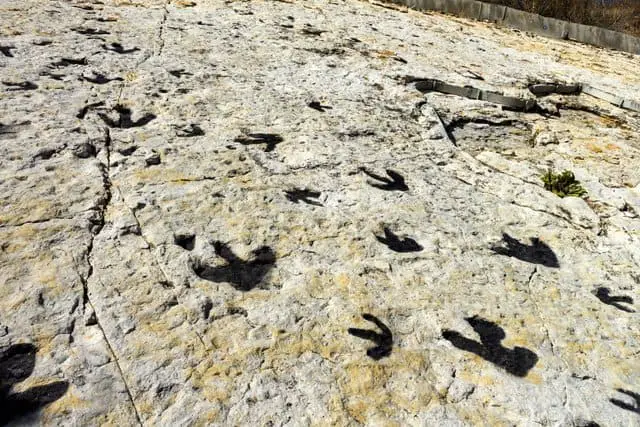
What Are Dinosaur Footprints Called?
The study of traces – dinosaur tracks, footprints, and plant impressions – is known as ichnology. Trace fossils such as dinosaur tracks and footprints are known as “ichnites”. Scientists and paleontologists who study ichnites do research on the size of the imprint, the shapes and also the length from one footprint to the other to determine the gait. (Source)
What Can Dinosaur Footprints Tell Us?
For starters, dinosaur tracks are great because they prove that dinosaurs walked on two or four limbs. Scientists can differentiate dinosaurs from crocodiles and other sea reptiles because of their unique hip structure that allowed feet to hold the bodies up while walking. By contrast, crocodiles walked on all four legs, and you can get visual confirmation of this by examining real dinosaur tracks.
Thus, we can tell that dinosaurs were not serpentine in their mobility. Paleontologists can also guess the dinosaur motion and speed from tracks if they are spread over some distance.
Dinosaur tracks can help in estimating the age and size of dinosaurs via comparative analysis. Researchers can use the tracks to determine walking and running speeds of dinosaurs, and how prey moved in comparison to hunters.
More importantly, dinosaur tracks are critical for analyzing the social behavior of different species. Tracks reveal species that moved in groups for herding and hunting purposes. Some of the prehistoric carnivores hunted in groups via organized routines.
Tracks show how parent dinosaurs walked side by side while protecting children in between them. Such clues are essential and complement findings from other paleontological disciplines in hypothesizing Jurassic sociology.
Where Can I See Real Dinosaur Tracks in the US?
Now let’s go into detail of the many places in the US and internationally. I start with the US locations and then cover places in Europe, South America, Australia, and China.
In the table below, I list the places globally where you can see real dinosaur tracks in the first column. Then I list the number of footprints, how old they are in millions of years (mya), and specify from which Mesozoic period they are from. Finally, in the last column, I indicate if you will need to hike and whether there is a museum at the location.
Table 1 - Places in the US Where You Can See Real Dinosaur Tracks
| Place | # of Footprints | Tracks How Old? Million Years Old (mya) | Mesozoic Period | Hiking Required? |
|---|---|---|---|---|
| Dinosaur Valley State Park (TX) | 10.000 + | 113 mya | Cretaceous | Yes |
| Dinosaur Ridge (CO) | 300 + | 150 mya | Jurassic | Yes |
| Dinosaur State Park (CT) | 2,000+ | 200 mya | Jurassic | Yes, also Museum |
| Clayton Lake State Park (NM) | 500+ | 100 mya | Cretaceous | Yes |
| Dinosaur Footprints Wilderness Reservation(MA) | 100+ | 200 mya | Jurassic | Yes, also Museum |
| Denali National Park, (AK) | 100+ | 70 mya | Cretaceous | Yes |
| Place | # of Footprints | Tracks How Old? Million Years Old (mya) | Mesozoic Period | Hiking Required? |
#1 Dinosaur Valley State Park in Texas
Dinosaur Valley State Park’s expansive area has dinosaur tracks on its 1,500 acres, and it’s full of tracks made by carnivorous theropods. The park supports activities such as camping, swimming, and hiking. If you transported through time to this area, you’d probably be trampled by the numerous four-legged plant-eating sauropods. The footprints in this park are dated to about 113 million years ago and are visible when water levels are low.
#2 Dinosaur Ridge, Morrison, Colorado
Located in Colorado, this location is a big research field for paleontologists seeking to study the evolution of avian dinosaurs. It is home to over 300 tracks of ornithopods and theropods. The park also offers guided tours by geologists to the public.
These tracks are much older than those in Texas and are estimated to be from 150 million years ago. Back then, the dinosaurs walked along sandy beaches that later transformed into Western Denver.
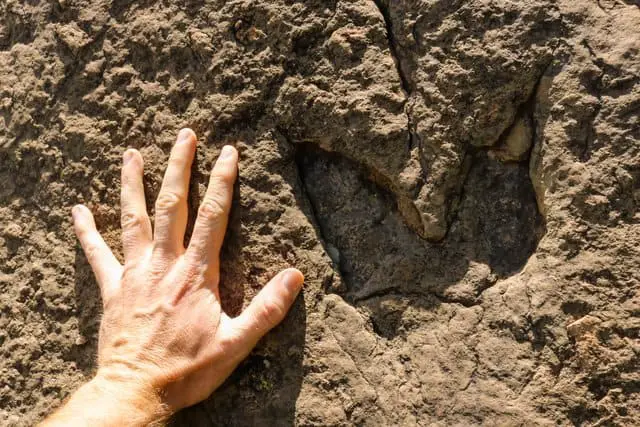
#3 Dinosaur State Park Connecticut
The Connecticut Dinosaur State Park has impressive dinosaur tracks discovered accidentally during some real estate developments in 1966. The fortunate accident led to the discovery of an iconic set of dinosaur tracks spanning about 55,000 square feet.
The 2,000+ fossilized tracks are now protected by the cover of a giant dome to preserve 200 million years’ worth of Jurassic data. The park also has an Exhibit Center.
#4 Clayton Lake State Park New Mexico
It’s a great place for real dinosaur tracks, and it is even referred to as the ‘Dinosaur Freeway.’ Most of the animals that made tracks on this perk were herbivorous avian dinosaurs and theropods. The tracks are diversified in that they vary in sizes suggesting dinosaur ages of between 0-30 years. The park offers rich prehistoric history; some tracks even show a dinosaur falling and using its tail to stand up again. The tracks are about 100 million years old.
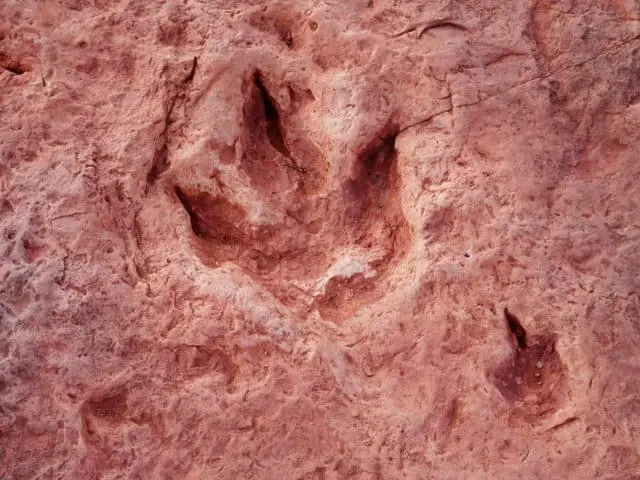
#5 Dinosaur Footprints Wilderness Reservation Massachusetts
This area features some of the oldest dinosaur tracks ever discovered within the United States. These real dinosaur tracks are from the early Jurassic period. Fortunately, it also entails tracks from different dinosaur species.
The Reservation has education programs for children, and hiking is required to reach some of the dinosaur tracks.
#6 Denali National Park, Alaska
Denali Nation Park proves that herbivorous theropods could live in Polar Regions in herds. The fossils and dinosaur tracks are from the late-Cretaceous period, about 70 million years ago. Along with the dinosaur tracks, multiple fossils have been found, which gives a picture of life at that time. (Source)
Where Are the Best Places to See Real Dinosaur Tracks Globally in the World?
As earlier determined, dinosaur tracks are rare, but they are evenly spread across the globe. You don’t need to be in the United States to track dinosaurs; you can do it from some of the following captivating places around the world.
#7 Isle of Skye (Scotland)
Seriously, this place is breathtaking, and it’s touted as Scotland’s Dinosaur Island. Whenever the tide rides low, tourists can enjoy the captivating site of dinosaur footprints. The tracks are about 165 million years old, and some are preserved within a small museum in the park.
In Table 2, like in the previous table, I list places globally where you can see dinosaur tracks and additional information in the columns.
Table 2 - Places in Globally Where You Can See Real Dinosaur Tracks
| Place | # of Footprints | Tracks How Old? Million Years Old (mya) | Mesozoic Period | Hiking Required? |
|---|---|---|---|---|
| Isle of Skye, Staffin Beach (Scotland) | 50+ | 170mya | Jurassic | Yes |
| Cal Orcko (Bolivia) | 5,000+ | 68 mya | Cretaceous | Yes |
| Dampier Peninsula (Australia) | 1,000+ | 140 mya | Jurassic | Yes |
| La Rioja (Spain) | 2,000+ | 120 mya | Jurassic | Yes |
| The Keates Quarry, Jurassic Coast (UK) | 1,000+ | 145 mya | Jurassic | Yes |
| Plagne, Jura Mountains (France) | 110+ | 150 mya | Jurassic | Yes |
| Natural Dinosaurs Footprints Monument (Portugal) | 1,000+ | 175 mya | Jurassic | Yes |
| Experienced Dinosaur Trails (.com) | 10,000+ | 90 mya | Cretaceous | No Hiking, Museum |
| Zhucheng City (China) | 3,000+ | 100 mya | Cretaceous | Yes |
| Place | # of Footprints | Tracks How Old? Million Years Old (mya) | Mesozoic Period | Hiking Required? |
#8 Cal Orcko (Bolivia)
The real dinosaur tracks in Cal Orcko are unusual because you must look up at a vertical cliff wall to see these tracks. It’s probably one of the most scenic and compelling because of the vertical experience. Isn’t it funny how tracks made on a flat beach surface can form the decorative essentiality of vertical natural barriers? The plates beneath the tracks clashed and tilted the beach into vertical landscapes. Over 5,000 footprints from over 450 different archosaurs go up to over 300 feet high.
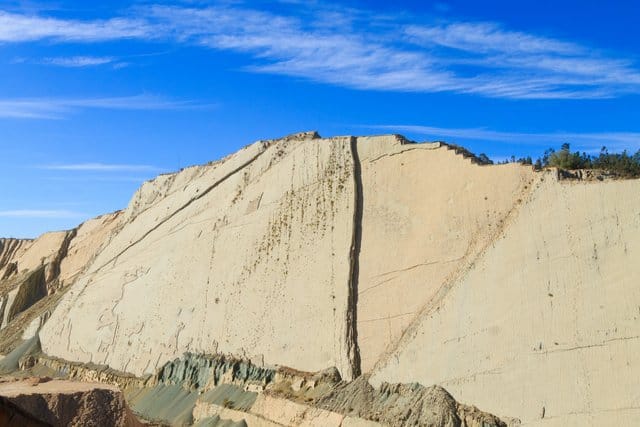
#9 Dampier Peninsula (Australia)
You’ll search the world and find the largest dinosaur footprint ever found at this location. Tourists love measuring the 5.5-foot-long dinosaur track left behind by some monstrosity from the Cretaceous period. (Source)
#10 La Rioja (Spain)
This park is rocky, expansive, and embedded with over 2,000 ancient, fossilized tracks. The tracks are on the grey rock, are contrastively visible thanks to their white, original cast. The Rioja Paleontological Centre will serve to provide vibrant museum displays and information regarding prehistoric Jurassic Spain.
#11 The Keates Quarry, Jurassic Coast (UK)
The Keates Quarry has an interesting collection of fossilized tracks dating from 140 million years ago. Scientists have confirmed over 1000 tracks made by some of the largest sauropods that ever lived on land. There were also carnivore tracks. Paleontologists suspect that the area served as a watering hole for the region.
————————————————————————————————
Related Dinosaur Articles You Might Also Be Interested In:
Herbivore Dinosaurs – What’s So Cool About Them? (Types, Sizes, Facts)
The 13 Best-Known, Most-Loved Dinosaurs and Why
What Are Long Neck Dinosaurs (Types, Size, List)?
————————————————————————————————
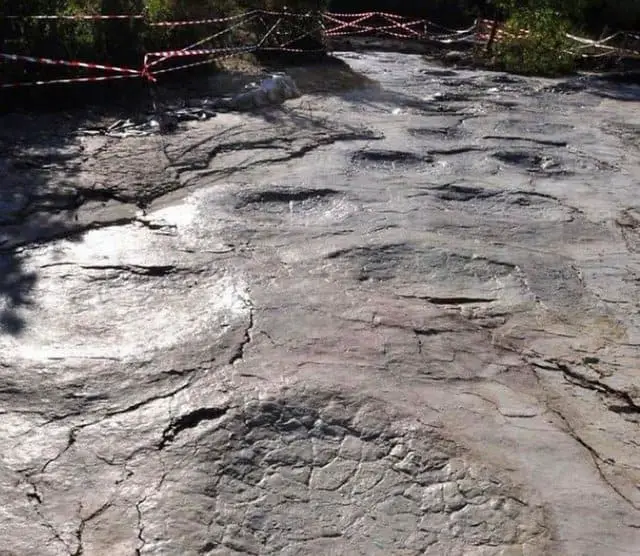
#12 Plagne, Jura Mountains (France)
You can see the most amazing track of dinosaur footprints in the Jura Mountains at a small village named Plagne. The path is 500 feet (150m) and makes it one the world’s longest sauropod trackways.
These dinosaur tracks come from the Jurassic period, some 150 million years ago, and the indentations made by the Sauropod are impressive.
#13 Natural Dinosaurs Footprints Monument (Portugal)
One of the oldest sets of dinosaur tracks can be found at Natural Dinosaurs Footprints Monument in Portugal. With over 1000 footprints, they are from the early Jurassic period and are about 175 million years old.
Hiking is required to reach this is, and the site is cordoned off so that you can see the dinosaur tracks.
#14 Grande Cache Dinosaur Tracksite, (Canada)
Located about 248.5 miles (400km) outside of Alberta, this former mining town has 22 sites that hold over 10k footprints. It’s the largest set of dinosaur tracks in Canada. It’s currently not open to the public, and rather they have a museum exhibit which shows many of the discoveries.
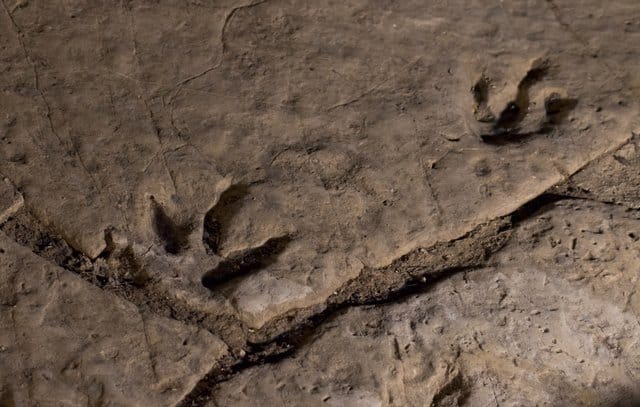
The dinosaur tracks are from the early Cretaceous period, approximately 90 million years ago. The types of tracks are herbivore dinosaurs like Ankylosaurus, Sauropods, and a variety of other dinosaur types.
#15 Zhucheng City (China)
Real dinosaur tracks have even been found in China, and at this site in Zhucheng City, it has tracks of the T-Rex.
The dinosaur footprints are estimated to be from the Cretaceous period, about 100 million years old. There are about 30 sites which interestingly have not only dinosaur tracks but also many types of dinosaur fossils. (Source)
At Zhucheng City, which is starting to be known as “Dinosaur City” in the Province, they also have a museum with an exhibition of the fossils collected in the area’s sites.
Final Thoughts
Isn’t it amazing that fossilized dinosaur tracks extending over miles (or kilometers) in places all around the world, and with just these impressions in the fossilized rock, tell us stories about how these giant dinosaurs lived millions of years ago? Walking along these real dinosaur tracks and following their paths gives one a sense of wonder and amazement. There are many more places in the world to find and experience dinosaur tracks, but you now have 15 places to start!
